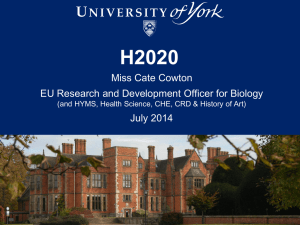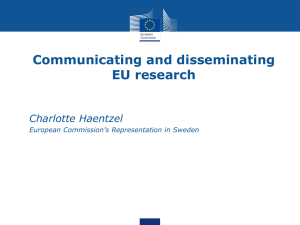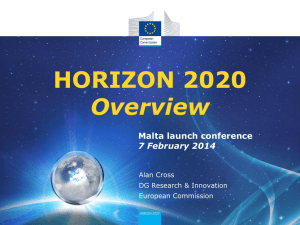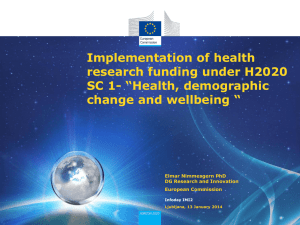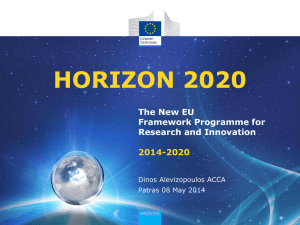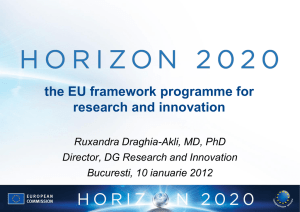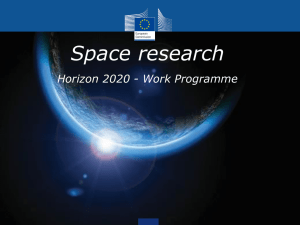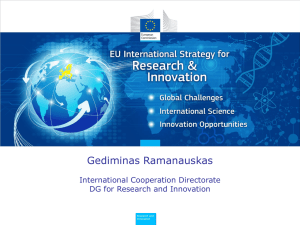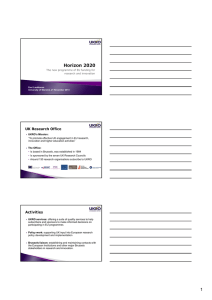PowerPoint-Präsentation
advertisement
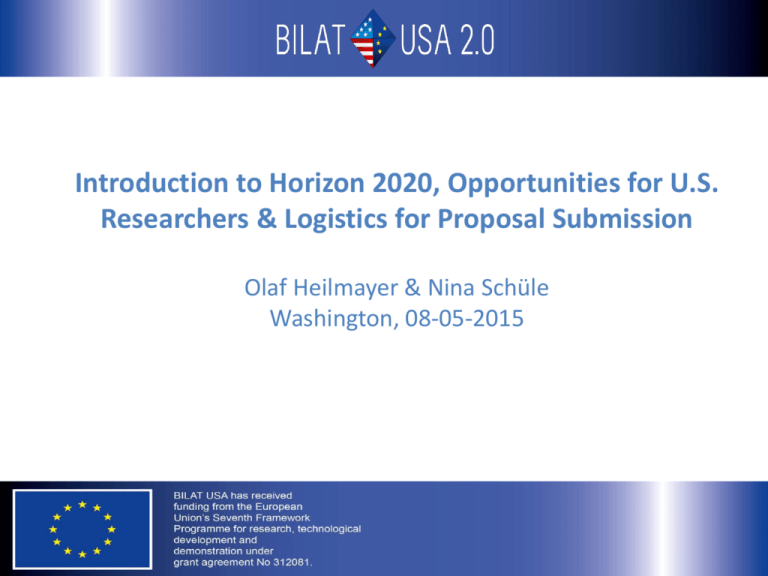
Introduction to Horizon 2020, Opportunities for U.S. Researchers & Logistics for Proposal Submission Olaf Heilmayer & Nina Schüle Washington, 08-05-2015 BILAT USA 2.0 - General Information Full project title - Bilateral Coordination for the Enhancement and Development of S&T Partnerships between the European Union and the United States of America Start Date: 1 November 2012 Duration: 3 years Total budget: 1.49 Mio. € Coordinated by: German Aerospace Center (DLR), Project Management Agency at DLR, European & International Cooperation Unit 2015/08 www.EuUsScienceTechnology.eu BILAT USA 2.0 Partners 2015/08 www.EuUsScienceTechnology.eu BILAT USA 2.0… Supports the political dialogue within the framework of the EU-US S&T Cooperation Agreement Enhances the cooperation between scientists and innovation actors on both sides of the Atlantic through targeted thematic workshops Provides information on funding opportunities to researchers and innovators Analyzes the state-of-the-art and progress of transatlantic science and technology cooperation 2015/08 www.EuUsScienceTechnology.eu U.S. Partners within FP7 Source: Austrian Research Promotion Agency (FFG) 2015/08 www.EuUsScienceTechnology.eu 2015/08 www.EuUsScienceTechnology.eu What is Horizon 2020 • A €80 billion research and innovation funding programme (2014-2020) • A single programme bringing together three formerly separated programmes/initiatives (FP7/CIP/EIT)*. • Coupling research to innovation – from research to retail, all forms of innovation • Focus on societal challenges facing EU society, e.g. health, clean energy and transport • Simplified access, for all companies, universities, institutes in all EU countries and beyond (=> openess for international cooperation). • Strong participation of SMEs • Open Access as basic principle for peer-reviewed scientific publications *The 7th Research Framework Programme (FP7), innovation aspects of Competitiveness and Innovation Framework Programme (CIP), EU contribution to the European Institute of Innovation and Technology (EIT) 2015/08 www.EuUsScienceTechnology.eu A stronger, clearer focus – 3 priority areas • to contribute directly to tackling the major societal challenges identified in Europe 2020 and its flagship initiatives. Excellent science • to contribute equally to creating industrial leadership in Europe. Industrial leadership 2015/08 Societal challenges • to increase excellence in the science base, essential for the sustainability and long term prosperity and wellbeing of Europe. www.EuUsScienceTechnology.eu Simplification as a major feature • A single set of rules covering all research programmes and funding bodies • Simple evaluation criteria: Excellence – Impact – Implementation (Excellence only, for the ERC) • Simplified funding rates (‚one rate per action‘) • 25% flat rate for indirect costs • Shorter average ‚time-to-grant‘; 8 month (5+3) • Grant Agreement is signed electronically • Less controls • Less time-keeping requirements (Abolition for staff working exclusively on an EU project) Beyond the Rules: further simplified provisions in the Grant Agreement and implementing procedures to facilitate access to Horizon 2020 (e.g. common IT platform). 2015/08 www.EuUsScienceTechnology.eu H2020 ‚Rules for Participation‘ apply for all programme areas (EIT, JTIs…) and funding bodies – exceptions where needed Simpler funding rates (basic principle: ‚one funding rate per action‘) Type of Actions Type of Organization 2015/08 R&IA IA Profit Direct costs = 100% Indirect costs= 25% Direct costs = 70% Indirect costs= 25% Non-Profit Direct costs = 100% Indirect costs= 25% Direct costs = 100% Indirect costs= 25% www.EuUsScienceTechnology.eu Programme Structure of Horizon 2020 Three Priorities I. Excellent Science Widening Participation II. Industrial Leadership Science with and for Society JRC (non-nuclear direct actions) Parts of Horizon 2020 2015/08 III. Societal Challenges www.EuUsScienceTechnology.eu EIT Programme Structure of Horizon 2020 I. Excellent Science ERC FET Marie-SkłodowskaCurie Research Infrastructures II. Industrial Leadership Leadership in enabling and industrial tech-nologies (LEIT)* III. Societal Challenges Health, demographic change and wellbeing … Bioeconomy ICT, Nanotechnologies, Materials, Biotechnology, Manufacturing and Processing, and Space Society JRC Climate action, Environment … …Societies Innovation in SME Secure Societies… 2015/08 Science with and for Energy Transport Access to risk finance Widening Participation www.EuUsScienceTechnology.eu EIT Budget allocation of Horizon 2020 22,09% 31,73% II. Industrial Leadership I. Excellent Science ERC FET MSC FIS 17,00% 3,50% 8,00% Enabling and Industrial Technologies (LEIT) 17,60% … Bioeconomy SME 3,69% 0,80% 9,70% 1,06% with and for Society 5,00% Energy 7,70% Transport 8,23% 4,00%… Climate action, Environment …Societies 1,70% Secure Societies… 2,20% www.EuUsScienceTechnology.eu Widening Participation Science 3,23% Total budget 2014-2020: 2015/08 III. Societal Challenges Health, dem change, wellbeing ICT, Nanotechn. Materials, Biotechnology, Manufacturing and Processing, and Space Risk Finance 77,7 billion € 38,53% 0,60% JRC 2,47% EIT 3,52% Societal Challenges III. Societal Challenges 1. Health, Demographic Change and Wellbeing 2. Food Security, Sustainable Agriculture and Forestry, Marine and Maritime and Inland Water Research and the Bioeconomy 3. 4. 5. 6. Secure, Clean and Efficient Energy 7. 2015/08 Smart, Green And Integrated Transport Climate action, Environment, Resource Efficiency and Raw Materials Europe In A Changing World – Inclusive, Innovative And Reflective Societies Secure Societies – Protecting Freedom And Security Of Europe And Its Citizens www.EuUsScienceTechnology.eu Societal Challenges Part III – Societal Challenges • 7 specific objectives which aim to contribute to solve important societal challenges of the Union – Policy driven: reflect the political priorities and societal challenges of the Europe 2020 strategy – Critical mass of knowledge and ressources in order to deal with the societal challenges • Largest budget share of 38,53% (about 26,5 billion EUR) • Interdisciplinary approach and inclusion of cross-cutting issues (gender, sustainablity, international cooperation…) • Entire cycle from basic research to market uptake • Stronger output orientation 2015/08 www.EuUsScienceTechnology.eu Who can apply? What are the basic rules? 2015/08 www.EuUsScienceTechnology.eu Rules of participation Applicants from non-EU countries are eligible to take part in Horizon 2020 programmes, even as coordinator. All proposals must meet certain minimum conditions (in Rules for Participation) Source: http://ec.europa.eu/research/iscp/pdf/inco_h2020_for_international_audience.pdf 2015/08 www.EuUsScienceTechnology.eu Minimum Conditions For standard collaborative actions: at least three legal entities - each established in a different Member State or an Associated Country. In addition, participants from any other country in the world can also be included Additional conditions can be set out in the work programme or work plan, e.g. number of participants, type of participants etc. 2015/08 www.EuUsScienceTechnology.eu H2020: Open to the world 1. Projects can include international partners 2. Targeted opening In certain topics in calls for proposals, inclusion of international partners may be: a) encouraged or b) required 3. Coordinated calls Used for specific actions (e.g. identified through joint steering committees). Paired calls, linked evaluations, two contracts Source: http://ec.europa.eu/research/iscp/pdf/inco_h2020_for_international_audience.pdf 2015/08 www.EuUsScienceTechnology.eu Eligibility for funding depends on the country • List of third countries eligible for funding (‚developing Countries’) (see General Annexes in Work programme) • No automatic funding for entities from ‚industrialised countries‘, BRIC (Brasil, Russia, India, China) and Mexico • only eligible for funding, if specified in the Work Programme or participation deemed essential for the project (outstanding competence/expertise, access to research infrastructure, access to particular geographical environments, access to data) or bilateral agreement between the EU and the respective country 2015/08 www.EuUsScienceTechnology.eu Legal framework EU Financial Regulation H2020 - Rules for Participation Work Programme Grant Agreement (GA) provides the rights and obligations between the EC and the beneficiaries Consortium Agreement (CA) provides the rights and obligations between the beneficiaries www.desca-2020.eu http://ec.europa.eu/research/participants/data/ref/h2020/grants_manual/amga/h2020-amga_en.pdf 2015/08 www.EuUsScienceTechnology.eu Specific Legal issues relevant to U.S. participants • Legal rights and obligations depend on whether the U.S. organization receives EU funding. -> U.S. beneficiaries who will be granted EU-funding: all rights and obligations of the Grant Agreement apply (Please check if your organization is legally entitled to sign the GA) -> U.S. beneficiaries who will not be granted EU- funding: some obligations especially those related to cost reporting will not apply (Article 9 GA). Other obligations will still remain: • IPR rules, transfer and licensing of results • access rights, dissemination of results incl. Open Access, ethics, adminisrative and financial penalities, • liability for damages. 2015/08 www.EuUsScienceTechnology.eu What next? How can I participate? 2015/08 www.EuUsScienceTechnology.eu Participant Portal – Single Entry Point to H2020 • One gateway principal • Public Area: – Register – PIC - Search – H2020 Calls and Documents • Private Area: – Submission – Contract negotiations – Contract changes – Reporting http://ec.europa.eu/research/participants/portal/desktop/en/home.html 2015/08 www.EuUsScienceTechnology.eu http://ec.europa.eu/research/participants/portal/desktop/en/home.html ECAS Account Register your organization 2015/08 www.EuUsScienceTechnology.eu Register your organization 2015/08 www.EuUsScienceTechnology.eu Register your organization 2015/08 www.EuUsScienceTechnology.eu Horizon 2020 Guide for US researchers A Guide to US participation in the European Union’s Framework Programme for Research and Innovation (2014-2020) http://www.euussciencetechnology.eu/sites/default/files/H20 20%20Guide%20for%20US%20researchers%20FINAL_0.pdf 2015/08 www.EuUsScienceTechnology.eu Get ready! Workprogramme 2016/17 will be published October 13th 2015! 2015/08 www.EuUsScienceTechnology.eu Next: NEW FRONTIERS IN SCIENCE DIPLOMACY Opportunities for U.S.-EU Cooperation 28 September 2015 Center for Transatlantic Relations Johns Hopkins University School of Advanced International Studies 1717 Massachusetts Ave., NW Washington, DC http://www.euussciencetechnology.eu/content/eu-us-science-technology-andinnovation-sti-cooperation-forum-%C2%B4new-frontiers-science 2015/08 www.EuUsScienceTechnology.eu Further Information Horizon 2020 Webpage (EC) http://ec.europa.eu/programmes/horizon2020/ Reference documents (e.g. Annoted GA) http://ec.europa.eu/research/participants/portal/desktop/en/funding/reference_docs.html Participant Portal http://ec.europa.eu/research/participants/portal/desktop/en/home.html IPR Helpdesk http://www.iprhelpdesk.eu/ Factsheet Horizon 2020 budget http://ec.europa.eu/research/horizon2020/pdf/press/fact_sheet_on_horizon2020_budget.pdf Fact sheet: International Participation in Horizon 2020 http://ec.europa.eu/research/horizon2020/pdf/press/fact_sheet_on_international_participation_ in_horizon_2020.pdf Factsheet on Industrial participation http://ec.europa.eu/research/horizon2020/pdf/press/fact_sheet_on_industrial_participation_in_ h2020.pdf 2015/08 www.EuUsScienceTechnology.eu Thank you for your kind attention! Come and visit us on our website! http://www.euussciencetechnology.eu Dr. Olaf Heilmayer// Nina Schüle (olaf.heilmayer@dlr.de// nina.schuele@dlr.de) 2015/08 The information in this presentation is rightly without obligation and has no right of completeness www.EuUsScienceTechnology.eu
